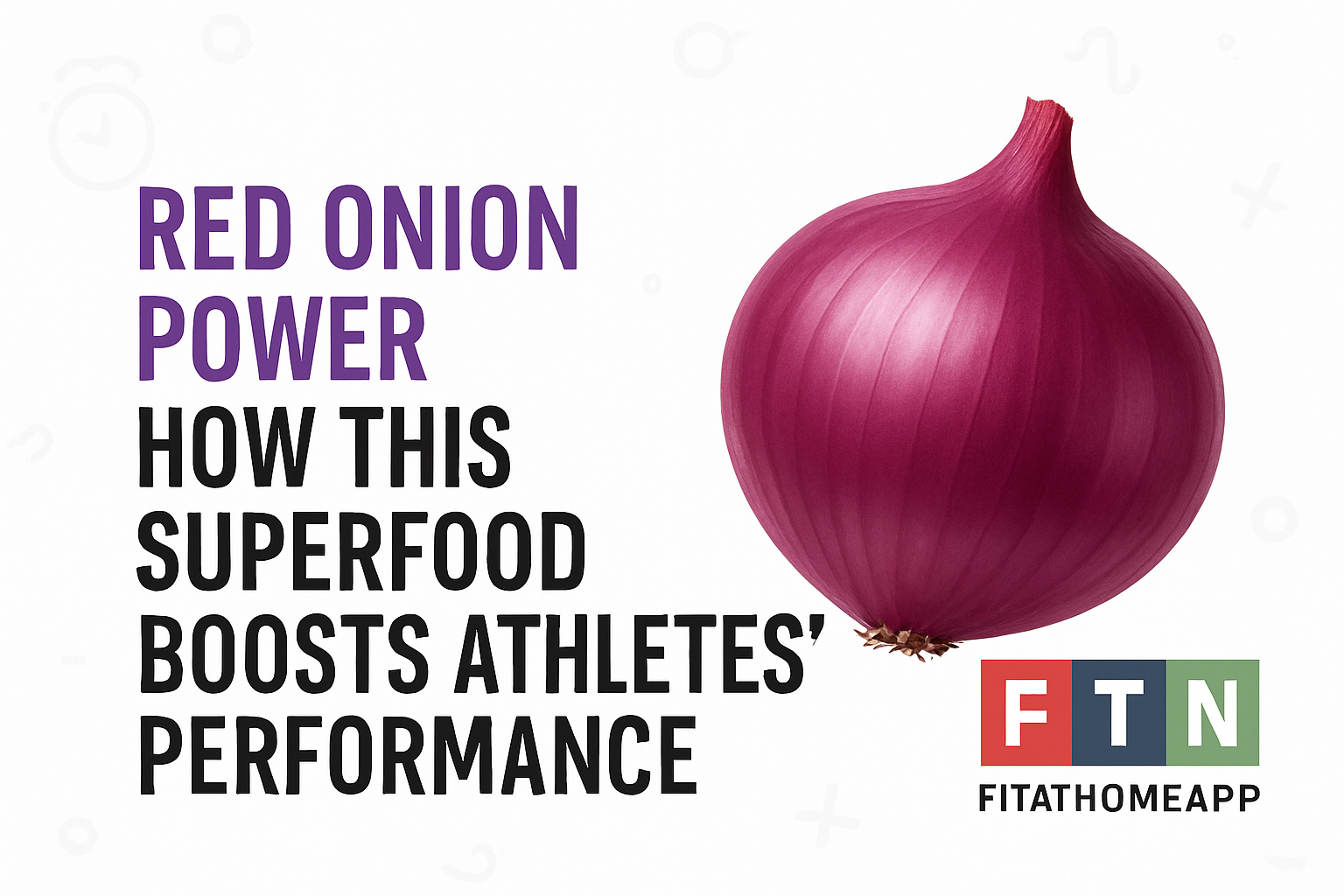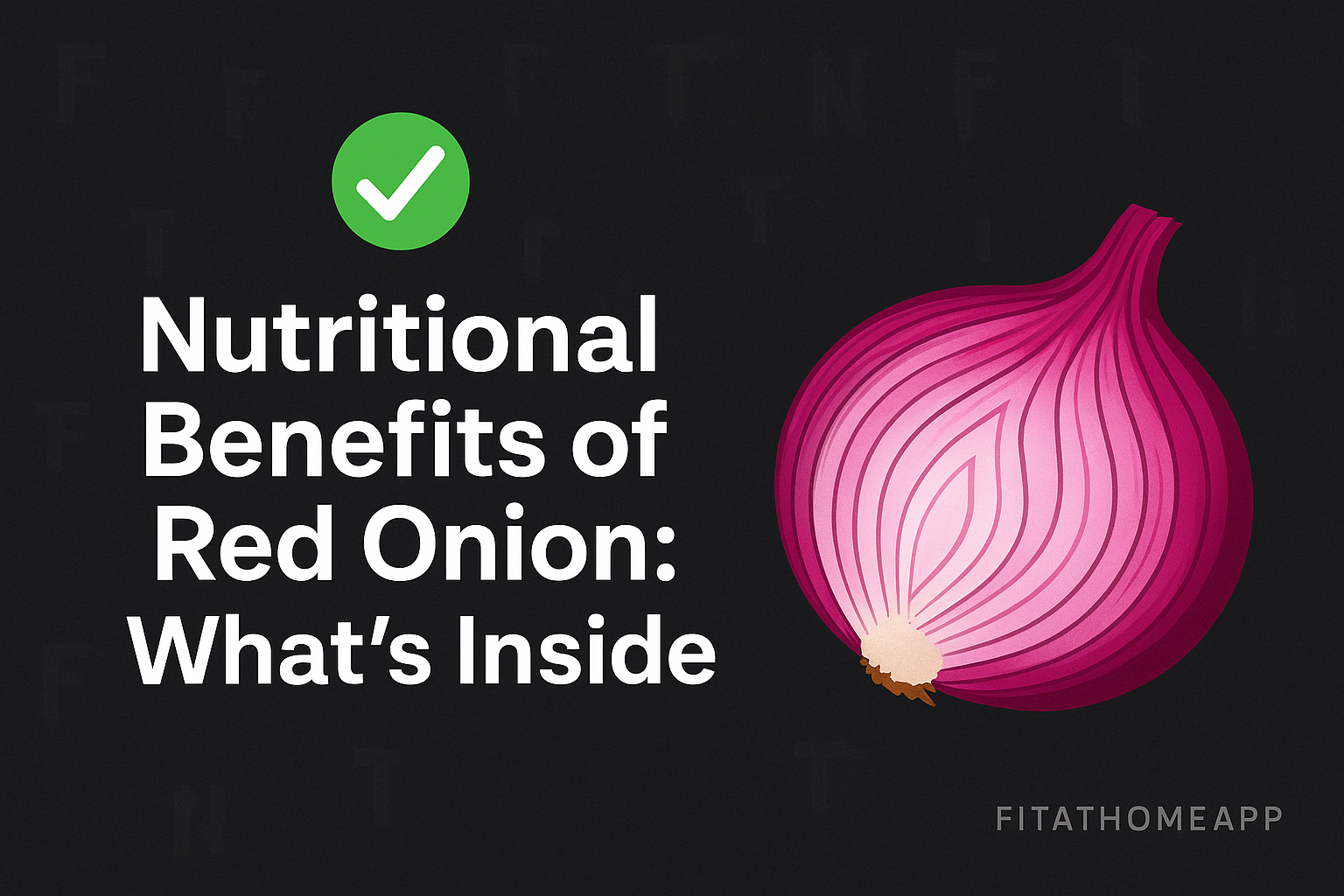✅ Nutritional Benefits of Red Onions: A Superfood Intro
Red onions are not just a tasty kitchen staple — they’re a nutritional powerhouse, especially for athletes ⚽️🏋️. With their vibrant color and distinctive flavor, red onions pack a serious health punch. Rich in antioxidants, fiber, and essential vitamins, they support performance, boost recovery, and help the body stay strong.
One of the stars of the show is quercetin, a flavonoid known for its anti-inflammatory properties. Combined with sulfur compounds and key vitamins like B and C, red onions are ideal for anyone looking to fuel intense training or improve general health ❤️🩹.
✅ Nutritional Benefits of Red Onion: What’s Inside
- Calories: Only 40 calories per 100g — a low-calorie option that won’t add unwanted bulk.
- Fiber: Supports digestive health and helps maintain energy throughout your workouts.
- Quercetin: A powerful antioxidant that fights inflammation and enhances recovery.
- Sulfur Compounds (like allicin): Aid detoxification and boost immune defense ⚕️.
- Vitamins B & C: Key players in energy production and immune support.
✅ How the Nutritional Benefits of Red Onion Help Fight Inflammation & Speed Up Muscle Recovery
🔹 Intense workouts lead to natural inflammation in the body. 🔹 Quercetin helps reduce muscle soreness and DOMS (Delayed Onset Muscle Soreness), making it easier to train more consistently. 🔹 Red onions help regulate inflammation markers, boosting the body’s ability to bounce back post-exercise.
By eating red onions regularly, athletes can reduce downtime, recover faster, and maintain higher performance levels 🏋️♂️.
4. Boosting Endurance & Cardiovascular Health
Red onions support endurance in multiple ways:
- Improved Circulation: Antioxidants promote blood vessel dilation, enhancing oxygen flow to muscles.
- Higher Stamina: Better oxygen transport = longer workouts with less fatigue ⚽️.
- Heart Health: Lower blood pressure, better cholesterol levels, and more efficient heart function.
Athletes across endurance sports like running, cycling, and swimming can benefit from the consistent intake of red onions ⛹️♂️🚴♀️.
5. Easy & Delicious Ways to Add Red Onions to Your Diet
🌿 Raw in Salads: Thinly sliced red onions add a crunchy, sweet note. Mix with leafy greens, cherry tomatoes, and vinaigrette. 🍔 In Sandwiches/Wraps: Adds flavor without excess calories. 🍽️ Caramelized: Gently cook with olive oil for a sweet, savory taste — perfect in grain bowls or omelets. 🍲 Roasted: Combine with veggies for a nutritious side. 🍜 In Dips: Mix chopped red onions with cream cheese or Greek yogurt for a post-workout snack. 🌿 Paired with Superfoods: Mix with avocado, garlic, or bell peppers for nutrient-dense meals.
6. Red Onion vs. Other Popular Healthy Foods
| Feature | Red Onion | Apple | Carrot |
|---|---|---|---|
| Calories | 40 per 100g | 52 per 100g | 41 per 100g |
| Fiber | ~2g per 100g | 2.4g | 2.8g |
| Antioxidants | Quercetin (High) | Polyphenols (Moderate) | Beta-carotene (High) |
| Taste | Strong, savory-sweet | Mild, sweet | Mild, earthy |
Red onions strike a powerful balance between flavor and function — making them a top pick for athletic nutrition ✅.
7. Pro Tips for Athletes
- Storage: Keep in a cool, dry place or the veggie drawer — lasts up to 4 weeks.
- Pick the Best: Look for firm bulbs with shiny skin.
- Prep Tip: Soak slices in cold water to reduce sharpness.
- Post-Cut Storage: Store in an airtight container to preserve freshness.
- Pair Smart: Add to protein-rich meals and complex carbs for balanced fuel.
8. Considerations & Allergies
🚨 While generally safe, some athletes should be cautious:
- Sensitive stomachs: May cause bloating due to FODMAPs.
- Allergies: Anyone allergic to the Allium family (onions, garlic) should avoid.
- Medication interaction: Can thin blood — consult a doctor if on anticoagulants.
9. Real Athlete Testimonials
“Adding red onion to my salads made a huge difference. I feel less sore after lifting sessions.” — Ahmed, powerlifter
“I love using caramelized red onions in my post-run meals. They add flavor and keep my energy stable.” — Layla, marathon runner
“Surprisingly, a simple veggie like red onion helped me bounce back faster from intense HIIT workouts.” — Sam, CrossFit athlete
10. Final Thoughts: Why Red Onions Deserve a Spot in Your Diet
Red onions are a flavorful, affordable, and nutrient-packed option for athletes seeking real performance benefits 🏆.
With powerful anti-inflammatory compounds, heart-supportive flavonoids, and energizing vitamins, this colorful vegetable can elevate your nutrition plan without overhauling your routine.
Whether raw, cooked, or blended into meals, red onions add more than just taste — they deliver real results. Start adding them to your plate today and experience the difference for yourself! 🥊💪
Personal Take on the Video
This video highlights the neuroprotective properties of quercetin found in red onions, explaining how the flavonoid supports nerve health, cognitive resilience, and protection from oxidative damage
Red onions are rich in quercetin, a flavonoid that offers powerful anti-inflammatory and antioxidant benefits.
Heart & Metabolism Support
Quercetin aids heart health by potentially lowering blood pressure and cholesterol while promoting gut and metabolic well-being.
Athletic Performance Benefits
Meta-analysis shows quercetin supplementation provides a small but significant boost in endurance exercise capacity and VO₂ max—a promising edge for athletes.
Blood Pressure Regulation in Hypertensive Individuals
Daily intake of around 162 mg quercetin from onion skin extract lowered systolic blood pressure by about 3.6 mmHg in individuals with hypertension.
Enhanced Insulin Sensitivity & Energy Metabolism
In animal studies, red onion extract improved insulin sensitivity and increased energy expenditure—benefits that could support athletic recovery.
The Powerful Link Between Garlic and Red Onion: Why They Team Up for Health
When you think of flavor and health, garlic and red onion often show up together in your kitchen—but there’s more than just great taste when you combine them. These two vegetables, both members of the Allium family, share similar compounds that support your body in many ways. They bring together unique abilities to protect, heal, and fuel your overall wellbeing. Below, we dive into how garlic and red onion work in harmony, and why embracing both in your diet magnifies their impact—especially when you understand the nutritional benefits of red onion.
🌱 1. Shared Roots: Alliums Unite
- Garlic and red onion belong to the same Allium genus, sharing several active compounds—organosulfur compounds, flavonoids, and other phytonutrients. These include allicin in garlic and quercetin in red onion.
- Because of this shared chemistry, many health properties overlap: antioxidant, anti-inflammatory, immune‑boosting, and cardiovascular supports. Food Struct+3TIME+3Healthy Food Guide+3
💪 2. Nutritional Synergy: More Than the Sum of Parts
While garlic is famous for its potent compounds and strong medicinal reputation, red onion brings its own nutritional profile that complements garlic perfectly.
- Garlic benefits: immune system support, lowering blood pressure, combating pathogens, antioxidant effects. Healthline
- Red onion benefits: rich in quercetin, good source of fiber, vitamin C, antioxidants, helps reduce inflammation, supports heart health. Healthy Food Guide+1
Together, they offer a powerful duo: garlic’s intensity and red onion’s gentler, antioxidant‑rich profile.
🧠 3. Targeted Health Impact: Heart, Immunity, and More
Here are the key areas where combining garlic + red onion can give you real results:
- Cardiovascular health: Both ingredients help lower “bad” LDL cholesterol and reduce blood pressure. Garlic’s sulfur compounds relax blood vessels; red onion’s quercetin helps protect blood vessels from oxidative damage. europrodotti.it+2Healthline+2
- Immune support & inflammation control: Raw or lightly cooked garlic delivers allicin, which has antibacterial, antiviral, and anti‑inflammatory effects. Red onion’s flavonoids help fight inflammation, strengthen immune response. bellaonline.com+2Healthy Food Guide+2
- Gut health & digestion: Both act as prebiotics or encourage a healthy gut environment via fibers and compounds supporting beneficial bacteria. TIME+1
🍲 4. Practical Ways to Use Them Together
You don’t need to take fancy supplements. These two are easy to work into daily meals:
- Start your stir‑fries or sautés by lightly frying red onion in olive oil, then add crushed garlic near the end so its active compounds aren’t destroyed by heat.
- Make salad dressings with minced garlic and raw red onion, paired with lemon or vinegar.
- Roast both garlic and red onion with veggies—garlic mellows and gives complexity; red onion adds color, sweetness, and antioxidants.
- Use them in soups, broths, or stews—reducing heat at the end to preserve garlic’s allicin.
✅ 5. Final Thoughts: Why the Combo Matters
The nutritional benefits of red onion are strong on their own; add garlic, and you multiply health effects. This combo supports your heart, immunity, digestion, and helps your body handle stress and oxidative damage better.
If you’re someone who’s serious about health—whether athlete, busy professional, or simply aiming for longevity—using garlic and red onion together isn’t just tasty. It’s strategic.



[…] Comparison between Leeks and Onions […]